REAL INDICATORS
“You can cut all the flowers, but you can't stop the arrival of spring”, writes Pablo Neruda. And in fact many have striven to cut flowers: there are those who have unleashed a war in the heart of Europe, who launched a series of increases in the cost of money, who triggered strong price increases for many raw materials, who went contending with the tail blows of Covid...
Nonetheless, the strength of growth pushes the sap of supply and demand along the tangled branches of the tree of the economy. A kind of greasy tree, because it is necessary to climb, with skill and speed, to reap the rewards of greater well-being. The force of growth is always at work, even when the economy is down, and it is made up of tension to ingenuity to respond with new and less expensive solutions to the material and immaterial issues that afflict humanity, and to drive to act to raise one's condition, corporal and spiritual, higher.
It is a force that is often underestimated and which lies at the very heart of the market economy. It mixes with scientific and technological advances. The latter today are la green , digital revolutions, seasoned and accelerated by legislative measures and tax incentives. If someone wonders where the strength of the question comes from, he can find two answers: the increase in employment and wages; the eldest stock of accumulated wealth.
We take the USA, which at current exchange rates remains the first locomotive in the world. The dynamics of real wage bill was 2,6% annualized in the last six months, despite the decline in February (-0,2% on January), while the household net wealth it has increased by $30 trillion since 2019, or $6 trillion a year, when it usually increases by roughly $XNUMX trillion a year. And this time both wages and wealth have increased in such a way that narrow the gaps a bit along the income distribution scale, so that the average propensity to consume has risen.
Similar dynamics are observed in Europe, where in some countries the push of the ngEU worth a few points of GDP; and Italy is among the major beneficiaries. Here, then, are the forces that explain the resilience of economies in the face of the latest war and energy shock.
Moreover, the war started by Russia has set in motion a new one arms race, which have the sole advantage of stimulating supply and demand, and which are basically not very different, macroeconomically speaking, from the Keynesian dig and fill holes, in the sense that the use of weapons opens chasms and causes destruction that sooner or later will have to be filled and rebuilt. While on the front ofthe energy prices are significantly lower than a year ago and availability is no longer in danger.
Here's what he paved the way of spring, for demand and for production (even in the southern hemisphere, albeit down there – down below – we go towards autumn).
ECONOMY: WHERE SPROUTS GROW BUT WATCH OUT FOR BLACK SWANS
That said, it should always be remembered that there is another variable that is often underestimated: sudden misfortunes, the 'black swans' that arrive without knocking (but in Australia they would be the 'white swans', given that down below swans are only black…). There war in Ukraine is in a stalemate, but stalemates are dangerous, because someone may want to break the stalemate, at all costs… And then there are the 'thresholds': rate hikes, in this anomalous monetary cycle, may not have many effects until they reach a threshold (which evidently has not yet been reached), but once it is crossed, the effects strike as a hammer blow. The run on the bank Silicon Valley Bank is it part of such black swans or does it signal the achievement of that threshold? Probably neither, but sure remember that the path of adjustment from a world of zero interest rates to one with “normal” rates (whatever that means) is full of stumbling blocks.
The same goes for another 'threshold', that relating to carefree stock markets… And then, among the risk factors, there are the increasing ones tensions between America and China.
Speaking of which, also the China can it have its own 'black swan'? It is not excluded, given that new ferments are agitating Chinese society, which is now much less submissive than before. However, the Celestial Empire took back its own locomotive role, even though Xi & C. are now aiming, more modestly, at 5% growth (which in any case is higher than the growth of the rest of the planet). And we must not forget, speaking of locomotives, that now theIndia it is now (in purchasing power parity) the third largest economy on the planet (after China and the USA), and both this year and the next it is growing and will grow more than China (after having overtaken it in number of inhabitants).
Where do the hands see i spring shoots shoot? In some qualitative indicators, which are the first to tell us how the situation is. Here then is the PMI in the output and order components (which are then future output). From which it emerges that the winter was really mild also in the economy, also thanks to the fact that it was meteorologically. And this is nothing new: the human history it experienced seasons of greatest development when the climate was favourable, and vice versa.
For output, the PMI data for February 2023 tell us that its fall has stopped and here and there, geographically and sectorally, it is expanded again, more in services than in manufacturing and more in China than in the USA and Europe. But sooner or later the beating of Chinese butterfly wings will also fill the US and European economic sails.
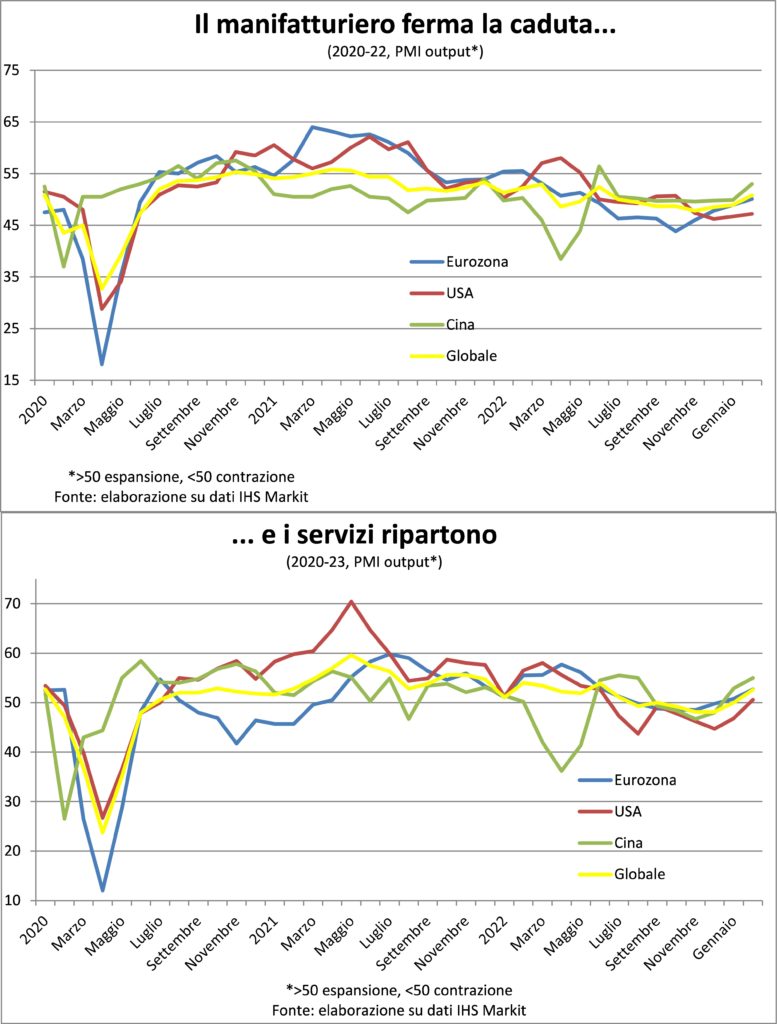
For the orders also in February there was an equally promising trend of copious blooms of activity, occupation, income, expenditure. Again more in the tertiary sector than in industry, and consequently more in the internal demand of the individual large macro-regions into which the world-economy is being segmented, and less in the export, which has its heart in semi-finished products.

INFLATION
“You are there – therefore you must pass. You will pass – and therein lies the beauty”, writes Wislawa Szymborska about the “evil hour” which gives “fear and uncertainty”. We could say the same aboutinflation.
We are all, economists, central bankers, financial markets, families and businesses, convinced that it will pass. even in theEurozone le consumer expectations they see it returning to 4,9% by the end of 2023 and 2,5% in three years.
That is, we all agree that we are not faced with another seventies style decade of the last century. Although by now we should all have learned that "never say never". The disagreements arise on the how long will it take for its passage and how many hammers of higher rates will require. Dissensions which, like a tectonic fault, pass through the various categories of "learned, medical and learned".
But let's take a closer look at some numbers and some changes in perspective. Until at the end of last summer the fall in inflation was believed to have begun and would be fast and linear. Then in the USA the data collection of the beginning of 2023 and the revision of the old ones arrived, so that it emerged that, as he said Jerome Powell, FED “chair”, in its recent congressional hearing, “the road to the 2% target is still long and is likely to be bumpy”.
On the other hand, the first mobile engine of inflation, i.e. the dynamics of cost of labor, remains buoyant, even though there is a slowdown in the February data, and that's because labor supply is tight. Both on this side and on the other side of the Atlantic. Just ask any entrepreneur in any sector to be told the story difficulty finding staff with low, medium and high qualifications. A difficulty that has made it difficult to satisfy orders in the last two years and is therefore that companies have continued to take even when the demand was less robust, so as to be able to be full ranks at the time of the restart. And these assumptions have translated into higher income which feeds consumption and therefore self-realizes the restart itself.
One way to see what is happening is to observe the Beveridge curve in the American labor market, a curve that relates the unemployment rate to the "vacation" rate of available jobs. The curve has shifted sharply to the top right, during the pandemic, signaling that there are many more places available than the number of unemployed. A condition of permanent upward pressure on wages. And there are very tentative signs of him returning to where he was previously.
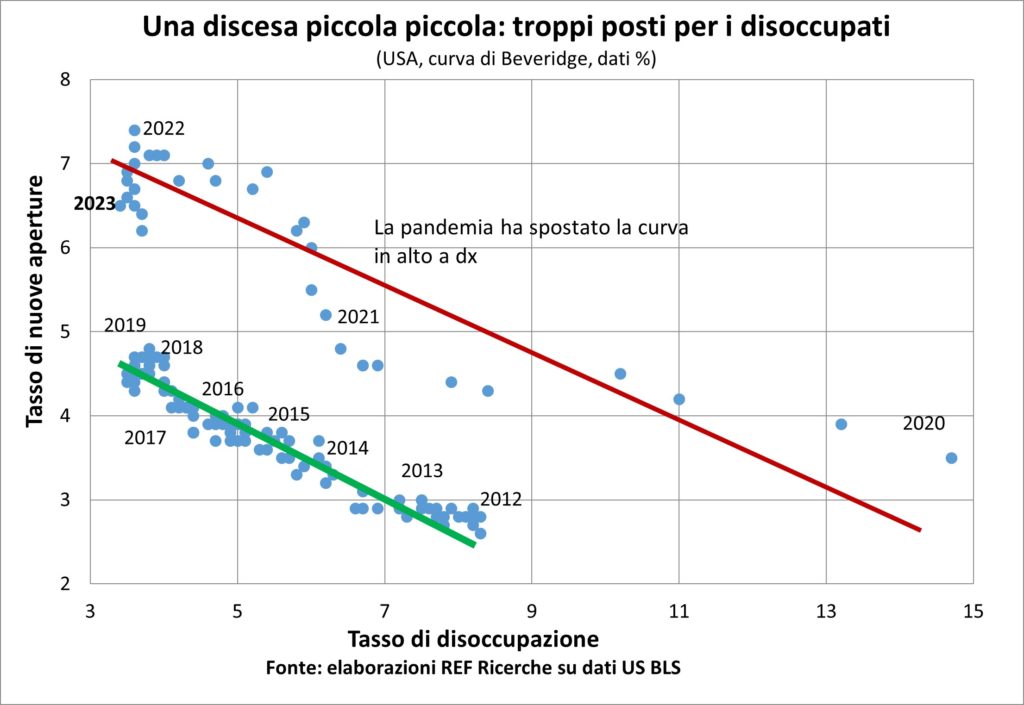
Another indicator, taken again from the PMI surveys of February, tells us that disinflation is indeed proceeding in costs but only in manufacturing, which has a greater intensity of use of raw materials (whose prices have fallen significantly), while it has stopped in the service sector.
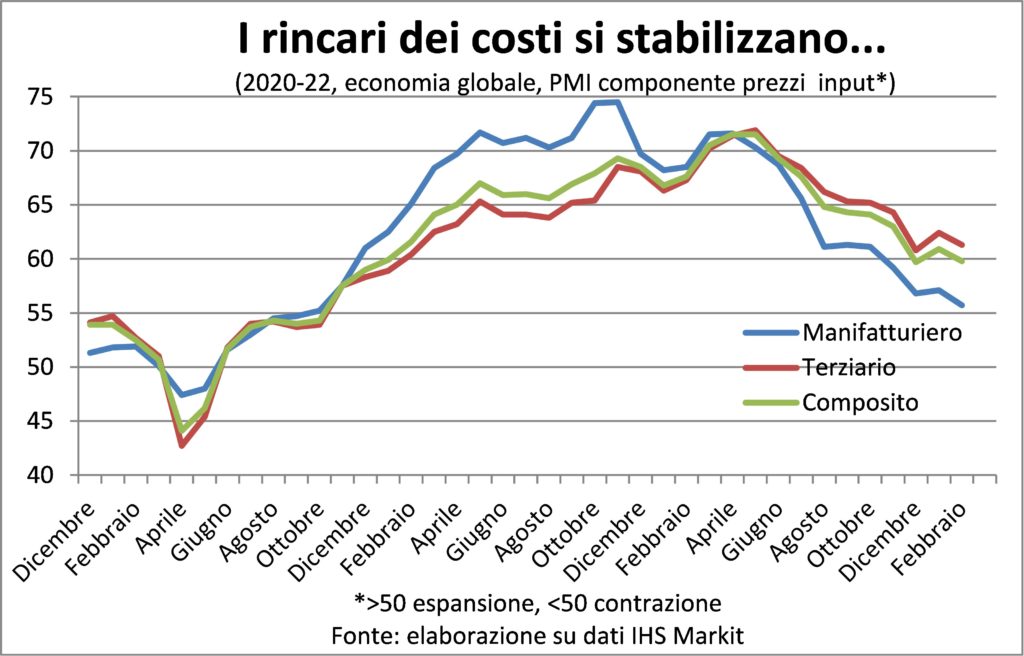
And for the final prices firms continue to unload downstream both past hikes in their purchases and new hikes in wages.
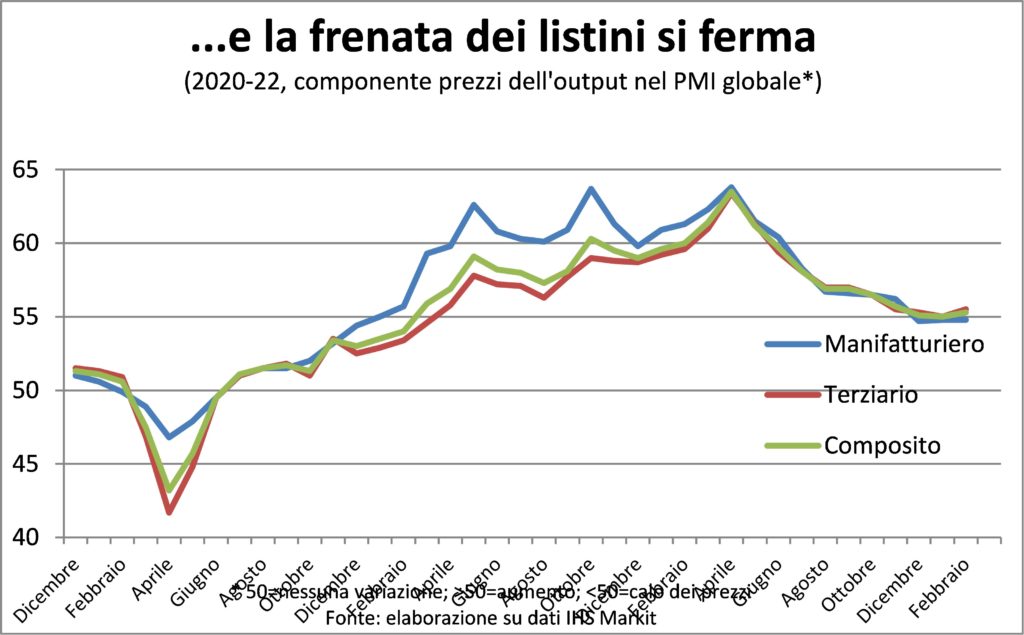
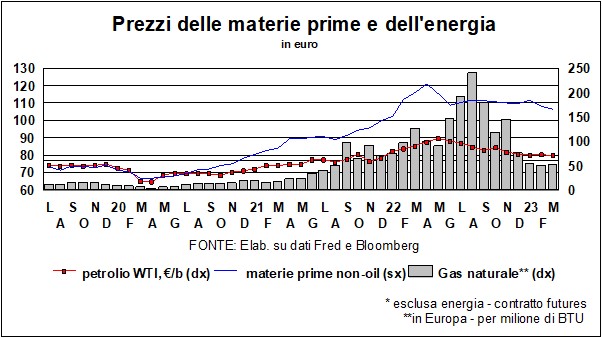
These indications have found confirmation in the acceleration dynamics of thecore consumer inflation in the euro area, and will probably find just as much validation in the analogous US measure.
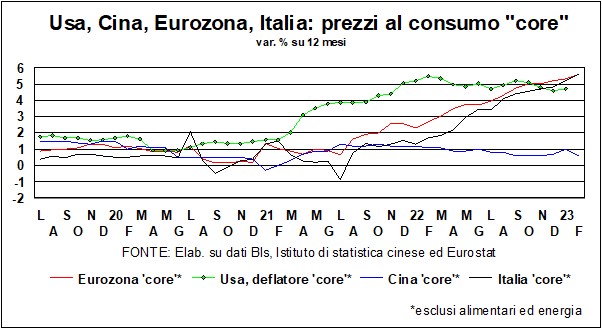
To sum up: inflation it's going down, but not as fast as some hoped. AND the longer it takes to drop the longer it will take to fall further, because wages will try to recover purchasing power, thus pushing costs and prices up.
RATES AND CURRENCIES
The yields of T Bond at 10 years they have been at levels not seen for 13 years for a few months, close to 4%. Even after the sharp descent of March 9 and 10. And rates have risen not only in America: in Germany the yield of Waist is the highest for 12 years, while for ours construction sector , as befits a country with increasingly agitated financial markets, the record for returns dates back a little less (10 years). Higher rates are not welcome for a country like ours, with a large debt to service, but at least, unlike what usually happens in times of rising rates, the spread with the Bund has not increased, on the contrary… Which raises two questions: first, why are rates high everywhere? Second, why isn't our spread widening?
The answer to the first question lies in monetary policies. The Central banks they have denied, with words and with gestures, the expectations of those who contemplated forthcoming reprisals: slowdowns, arrests, or even reversals in interest rates. And there are at least two reasons for this resolution: on the one hand, inflation (the background one, excluding food and energy) shows no signs of declining, on the contrary… On the other hand, the economy, as mentioned above, holds longer than expected, and this encourages the Banks to persevere in the squeeze, hoping to win the Holy Chalice: defeating inflation without triggering a recession.
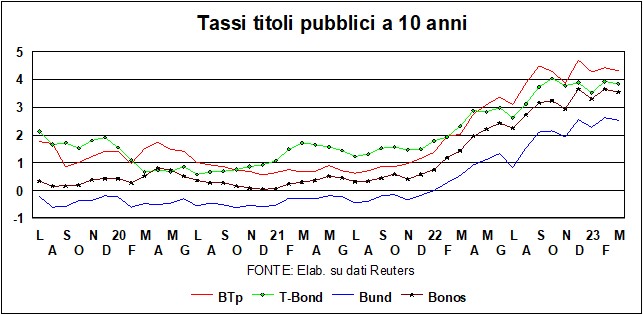
The answer to the second question is comforting. The budgetary policy of the Meloni government has been prudent, in the wake of the Draghi government, and this has reassured the markets (which markets also know that the ECB has the TPI, the OMTs and assorted initials in the weapons room…). Compared to the highs of last September, when markets were worried about the election (not so much about the outcome, but about what the new government would do), the spread has gone down about sixty points on the Bund, and about fifty points on the Bonos.
THEyield curve inversion it is, to date, a reality for 33 countries. for theAmerica has reached levels (see graph) not seen since the ruthless monetary tightening of the legendary Paul Volcker in 1980 (apart from the 2-year T-Bond, the Federal Funds are now well above the T-Bond 10 years – and there is also a reversal in long maturities, with 30 years yielding less than 10 years).
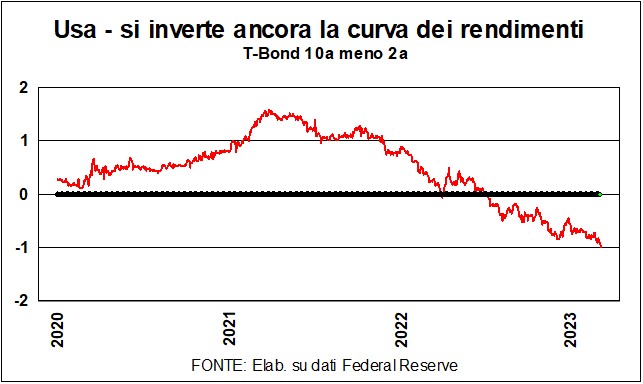
Should we be concerned about this reversal, given that it is usually associated with a weakening economy? The traditional interpretation it sounds like this: i short rates are higher because the central bank tightens, this tightening will cause a recession, the demand for funds will drop and therefore the long rates fall below short rates. But there is in the present climate, too another interpretation: the first part is the same, short rates are high because the Bank wants to stop inflation; the second part says: the markets believe that inflation will decrease and therefore those who ask for money in 10 years do not need a yield that takes current inflation into account, but only looks at future inflation. This interpretation is confirmed by estimates of expected inflation, which see a price dynamic – both calculated from household surveys and derived from market measures – well below today's inflation. In both cases, the inversion is in the mind of the markets, a mind full of imagination and changeable in orientation…
This yield curve it is also reversed for Germany, for France… but not for Italy. Which may seem good, given that usually, as mentioned, the phenomenon of the reversal is a precursor of the recession. But in our case, the yield of the btp at 10 years it remains high because Italy has permanent risks: a political risk and a high public debt (the total debt, in reality, is not a debt, since Italy has an active and significant net foreign position).
On the markets of you change, there is calm. As can be seen from the graph, the fluctuations, both for the dollar/euro that for the dollar/yuan, are rather contained, and even the (relative) surprises such as Powell's words about the rise in interest rates (which watered down expectations of a slowdown) have not moved the exchange rate much. Perhaps because on this continuation of the squeeze both the Fed and the ECB march together and therefore there is no reason to spread the fate of exchange rates.
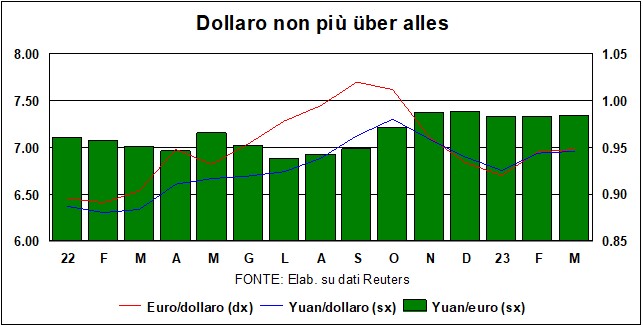
Where there would be matter of surprise lies in the (relative) maintenance of stock exchanges (despite the 'grey swan' of US banks, which also has no serious potential for contagion). With rates rising, one might think that stock prices are going to suffer. After all, these quotations, according to theory, should be nothing more than a lump in which the future profits, updated to date with an appropriate discount rate; and, if that rate rises, the present value of future earnings shrinks. Here, however, the difference, just mentioned, between current inflation and expected inflation. It is not at all clear whether future earnings should be discounted with today's or expected Federal Funds. Of course, then on Bags, which often move without rhyme or reason, factors of moods, fears and hopes also weigh, the conjunction of which leads to predictions whose reliability resembles that of the haruspexes, who relied on the lucky stuttering of the birds or on the distant counterweight of the stars. Well, the stock exchanges are in the grip of one “irrational exuberance” (at Greenspan), or a “rational exuberance”? We fear the former and hope for the latter…





